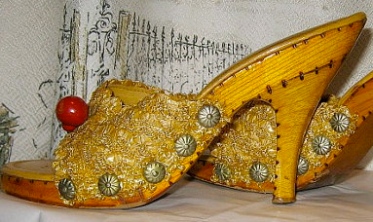She is 86 years old. My aunt. My mother’s sister. Not many people know about her because I don’t talk about her. Call it tradition, but in our family, someone with mental illness was ‘invisible’ – we don’t “talk about such things” – they were sent away – out of sight and out of mind. Portuguese families who came to this country and became citizens were always afraid of something that would ‘get them into trouble’ – fear of being sent back? Not sure.
When I entering college I decided to major in psychology. Maybe more to understand my family’s odd behavior than to understand my aunt. I grew up in an extended family – all on my mother’s side – along with my silent German-English father.
My aunt and I got along quite well. We do to this day. She has never held a real job – some “piecework” in a jewelry factory on a “foot press” for a few weeks or more at a time. A long time ago. She made some beautiful, highly detailed crafts, wrapped them in Saran Wrap, and sold them at small boutique shops, too. And she washed and ironed shirts for her brother, my uncle, who owned a restaurant/bar and he paid her 25 cents each to do them. 25 cents. Looking back, that was cruel. Almost a sick joke. She got out the stain of grenadine meticulously – scrubbing them on an antique wash board – in steaming hot water until her hands would bleed. She ironed every crease, and starched them perfectly. They were set up on a small rack in a corner of the kitchen – those shocking white shirts – those perfect shirts – those 25 cent shirts.
When I was in my teens they took her away one day. She tried to melt red candle wax in a porcelain pan on the stove, and pour the wax into molds – always the creative one. Nearly burned the house down and freaked her right out. Her father, my grandfather, went after her. It was a nasty scene. And just like in One Flew Over the Cuckoo’s Nest, they came. The small white van – the men in white. Really! They wore white pants like ice cream cone servers. The pants were whiter than the straight jacket they put around her as they took her 5 foot slender shrieking body out the door sideways, held like a rolled up carpet. Or the stogey my grandfather held between his fingers as he watched her go. One more time. Then he played cards. His Solitaire game.
She came back in a week. I remember she smelled so different. And she walked like my Walking Debby doll. She stared at her feet and moved them one at a time. She’d look up and smile. They called it The Haldol Walk, the look, the s-l-o-w m-o-t-i-o-n of it all. That scene would be repeated numerous times, each time I would be a little older, a little more removed. Waiting for my own foot out the door. Can I go yet? Please?
In the quiet times of her mental illness, she was my best friend. Children, especially only children, gravitate to single aunts with time on their hands, as did I. We made pictures. She laughed at how talented she was and how I had none of it, whatsoever. She marveled at how the talent had not made it down the genetic chain. (But would the mental illness?) She taught me to crochet. With size 0 metal crochet hooks. And we made pies together. Peach pies. Pies you made from scratch, dough and all. We made lots of them, using tin pie plates and wooden rolling pins. We used my grandfather’s fishing sinkers as pie weights. Sometimes we made apple pies. I remember slicing slivers of butter to put on top before we closed them up for baking. And cutting little patterns in the dough with a fork.
We liked to catch kittens, she and I. There were always strays. We would hide them in the greenhouse at the back of the yard. Sometimes we would feed them for weeks and weeks, and play with them until they grew and started to walk around the yard, and over to the house and, well, then they would just disappear somehow. My aunt and I never knew where they went. That was sad. We waited for new kittens – they always came.
She even drove a car. A 1954 Rambler with a push button gear box on the left of the dashboard. She wore high heels – stilettos – my favorite pair were made all of wood with beachy symbols on them and straw. I wonder if they were like those that Annette Funicello wore in Beach Blanket Bingo – my aunt loved Annette.
The years passed. I went to college. I grew all the way up. I got married and had my own children. She was lost for many years, my aunt, not sure how she managed. She didn’t live at her home anymore – but she was never homeless. One day I was called from a hospital and when I went to see her it was a bad scene. She was in restraints. Wild, really. Didn’t know what my name was, though she did recognize me. She spent some time in a mental hospital, and then seemed to be really fine. But she hated her meds. She couldn’t draw. She couldn’t read. Her mouth was dry and pasty. And she fell asleep a lot.
Years would go by. Another call. Local police. She was throwing her clothes out her window and could I come. Another hospital. Four point restraints. Looking a little bit like the Exorcist child now. Age had done that. 24 hours, and meds returned her to sanity. And then to the mental hospital. Another 10 day hold.
Did fine. Returned back to her apartment, but they were treating her badly there. So I helped her apply for SSDI – the first “handout” she had ever had. She still never had health insurance, or food stamps, or subsidized housing – or a family to help – just me – now ashamed at how little I had been there. We went to the psychiatrist and certification came pretty easy. We managed SSDI with the help of a pro bono attorney who knew that I would be the one to pay for his services, so he said, ‘never mind’. Today she lives in subsidized housing and she still drives. She has food stamps, though rarely uses them. She is quite healthy. Vision failing a bit. 86 now.
My whole life I have tried to keep her out of ‘the system’ – the places that would send men in ice cream pants to wrap her up like a rug and take her out the door sideways. And what unspeakable things happened to her before she would return, flat, dissolved, absent? Those men and women in pale uniforms who would tie her up in brown leather four point restraints covered with white wash cloths to guard her thin wrists and ankles. The ‘new’ psychiatric hospital that tried talk therapy, and group therapy, and she would just smirk and smile and tell them ‘you’re crazy, you know…I’m not crazy…what are you talking about…ehhh, you’re kidding me. Nooo.’ She would smile. I would, too. Hoping the laugh coming over me would stop.
She has humor and gentleness. Except for the time she locked me in her apartment when she was in her 50s and told me that she could kill me and I could disappear and no one would ever know what happened to me. Hmm. I stayed away for a long time when that happened – me, trying to talk my way out the door – she, standing in front of it – grinning. I was a mother now – no time to go getting cut up in little pieces and taken out with the trash.
Today we shop together; I take her to the doctor’s; I take her to social security when our new system begins to question her and I talk nicely to the 20 something year old clerk who says to me, ‘she never did pay into the system, did she?’ and I just smile. She holds her own, my aunt. If I try to help her with all the papers she has stuffed in her purse, she swats at me – with her strong, frail hand.
She does well away from the systems, the mental health professionals who had no idea then or now about what was wrong and how to fix it. She has eked out a life for herself. She has done it alone, and in silence. The silence of mental illness. The dark rooms behind wooden doors, behind metal doors. The programs that do not work. The system that only sought to wrap her up and throw her away. The meds that eased her angst, but flattened her personality.
Today we house 30 people a night, I’ve read, in the emergency department of RI Hospital – because there are no beds. A teenager who wants to kill himself resides, as an unregistered patient, at another RI hospital because there are no beds – and nurses take turns buying him McDonalds’ food because he can’t get a hospital tray – remember, he’s not admitted nor discharged. He is not even there.
And millions were spent on a big new building at the other psychiatric hospital for – how many? – 24 beds. 24. And they were almost at once – full. No room left there. We closed the IMH (Institute of Mental Health) years ago, and our mentally ill are on the streets, or maybe the lucky ones are in day programs and group homes, or living somehow marginally. Where are the violent ones? Where are those who at one point or another think about the unspeakable – or do it? We read about the few.
I have spent my career, for the most part, in the nonprofit world – always on the periphery of mental ‘health’, physical ‘health’. But now I am raising my voice to tell a story – of one person, one red haired, slight, 100 pound lady who walks on her toes, who listens in the dark to her radio – who warms up food in hot water because the microwave (my gift) is a mystery. She whispers on the phone in the closet – when we speak – because “they” are listening. And she has one small lamp on, too, so “they” can’t see her. She’s convinced the security cameras can see around corners and into her room. She talks to me about current events, about how it has been 50 years since John F. Kennedy was assassinated. Imagine that? 50 years.
Each December and each April my daughters receive a birthday card with $2 or $3 or $5, cash in it. At Christmas and Easter there are cards, too – along with this wish for them – written in flamboyant and beautiful cursive writing – “I hope you are well. Remember, if you don’t have your health, you don’t have anything. Love,”



